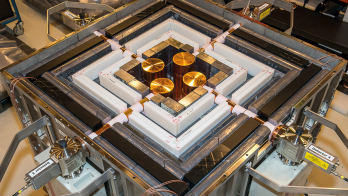
Image credit: J Ordan/CERN.
The Deep Underground Neutrino Experiment (DUNE) in the US, the cavern for which entered construction this summer, will make precision studies of neutrinos produced 1300 km away at Fermilab as part of the international Long-Baseline Neutrino Facility. The DUNE far detector will be the largest liquid-argon (LAr) neutrino detector ever built, comprising four cryostats holding 68,000 tonnes of liquid, and prototype detectors called protoDUNE are being built at CERN.
Each protoDUNE detector comprises a 10 × 10 × 10 m LAr time projection chamber with a single-phase (SP) or dual-phase (DP) configuration, containing about 800 tonnes of LAr. While the two big cryostats housing the detectors are about to be completed, the construction of the protoDUNE detectors themselves has just started. The first of six anode-plane-assembly modules for the protoDUNE-SP detector, which will detect electrons produced by ionising particles passing through the detector (pictured) recently arrived at CERN. The module will be tested, together with its electronics, and then installed in its final position inside the cryostat.
In parallel with the anode-plane-assembly, other parts of the protoDUNE-SP detector are being assembled at CERN, including the field cage, which keeps the electric field uniform inside the volume of the detector. Around a quarter of the 28 field-cage modules have already been assembled and are stored in CERN’s EHN1 hall, ready to be installed. The assembly and installation of the detector parts is expected to be completed by spring next year, in order for protoDUNE-SP to take data in autumn 2018.
The protoDUNE detectors are among several major activities taking place at the CERN neutrino platform, which was initiated in 2013 to develop detector technology for neutrino experiments in the US and Japan.







